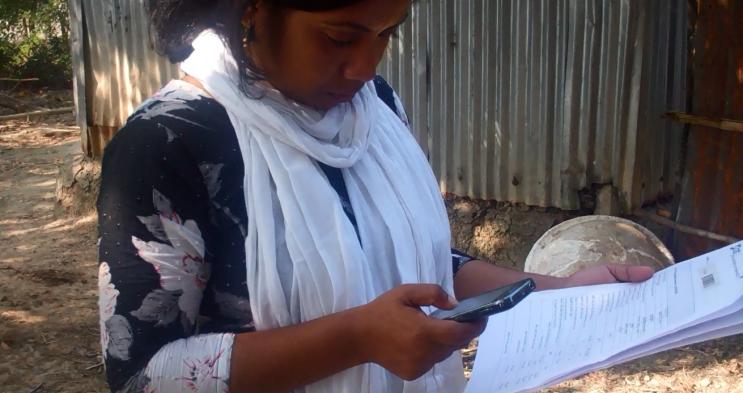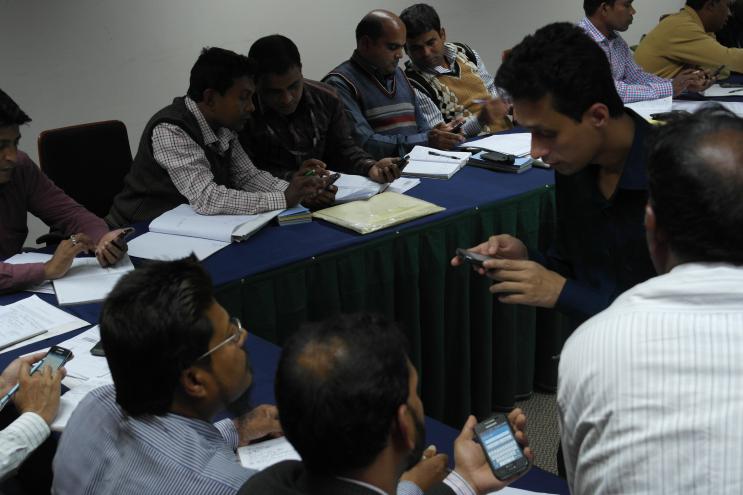In Bangladesh millions of toilets have been constructed. How do you know if they're being used safely? Smart new software may provide the solution.
Published on: 03/06/2014
Imagine that you supplied toilets to 30.7 million people and now you need to know if they’re being used safely. That’s the challenge facing the BRAC WASH programme in Bangladesh. Smart new software may provide the solution. And if it works for BRAC in Bangladesh, it should work in any small to mid-sized country or project.
Back to the example of 30.7 million with access to hygienic toilets. I would like to use this impressive fact to illustrate how monitoring at scale works in practice and how ICT tools make a huge difference.
Let’s get back to those 30.7 million people who have gained access to hygienic toilets. How is this data collected? The number of toilets – although huge! - is relatively easy to count. That is, if you have enough field staff to talk to the village WASH committees and if you have an independent quality and control team to cross-check the numbers. This is all part of the Quality Control and the Monitoring Information System (MIS) developed and implemented by BRAC. So far so good.
However, having only the number of toilets was not sufficient for BRAC WASH. They want people to have access to safe toilets and for them to practice hygienic behaviour even after BRAC WASH leaves the programme area. Safe toilets are defined as toilets that separate human waste from toilet users; this means that faeces may not come in contact with people when they use the toilet. For most of the toilets in Bangladesh this means that there should be a functioning water seal. Also, no faeces should be visible in and around the toilet pan. Measuring this goes beyond ‘counting beans’, not only in defining indicators, but also in the way to collect data: data collectors actually have to go and visit a toilet to check if there is a functioning water seal. Enter QIS: the: Qualitative Information System.
.
BRAC introduced and developed the QIS monitoring system together with IRC. The monitoring team developed a series of mini “scenario scales" where level 0 represents non-performance (e.g. open defecation) and level 4 represents ideal performance. QIS is a valuable addition to the Monitoring Information System (MIS) because it quantifies qualitative data on outcomes so it becomes easier to analyse and to visualise.
To make data collection and data processing easier, project staff used smart phones to enter and upload data to a database. They collected data, in two phases, from 11,600 households spread over an area which covers half of Bangladesh. During the last phase, covering 3,600 households, the whole exercise from sampling to training and actual data collection by 40 teams of data collectors took 8 weeks.

So now we have the data – be it in two separate data sources. How do we analyse all this? How do we get the results presented in such a way that they can be used to improve the programme? Since the start of the project, the quantitative and qualitative data had to be combined manually to be able to make use of both types of data for the analysis.
It’s a rule of thumb that you need three times as much time to analyse data than to collect data. Until now, the quantitative and qualitative data had to be combined manually to be able to make use of both types of data for the analysis.
Unfortunately, it is also a rule of thumb, that this is not acknowledged. Monitoring activities focus very much on data collection and much less effort is spent on analysing and using the data. The same goes for ICT monitoring tools available, according to Joseph Pearce. In the summary of an e-discussion on water point mapping he says that ICT tools focus more on data collection than on analysis (Pearce and Howman, 2013).

BRAC WASH together with IRC and BeDataDriven are changing this. BRAC ICT and BeDataDriven are jointly developing and fine-tuning software to support the final steps in the monitoring process. With this new software you can combine different types of data sources (MIS and QIS in our example), run an analysis on the data, visualise the results and produce a basic report showing it all. This software will become a new version of ActivityInfo, which was developed by BeDataDriven and will be integrated with BRAC ICT’s existing systems (Raju, 2013).
The proof of the pudding is in the eating, and that eating is going to start soon by doing the whole monitoring exercise from sampling to reporting using the new data platform. If it works, the BRAC WASH team can do integrated performance monitoring independently from IRC support.
Imagine the implications this can have for governments and other WASH sector organisations! The ICT application will be able to include other data sources like data on service level costs. It is open source, so anyone can use it. We think it is very promising. Want to know more? Watch this space!
References
Pearce, J and Howman, C., 2013. RWSN Water Point Monitoring Group: a synthesis of experiences and lessons discussed in 2012. St. Gallen: Rural Water Supply Network Secretariat, SKAT Foundation. Available at: http://www.rural-water-supply.net/en/resources/details/450
Pearce, J. and Welle, K and and Dickinson, N., 2013. Information and communication technologies (ICTs) for monitoring sustainable service delivery.Keynote paper for Topic 4 of “Monitoring Sustainable WASH Service Delivery Symposium”, 9 to 11 April 2013, Addis Ababa, Ethiopia Available at http://www.ircwash.org/resources/information-and-communication-technologies-icts-monitoring-sustainable-service-delivery
Raju, S.I., 2013. Monitoring service delivery: BRAC's experience with iCRESS. Presentation at "Monitoring Sustainable WASH Service Delivery Symposium", 9 to 11 April 2013, Addis Ababa, Ethiopia. Available at: http://www.slideshare.net/ircuser/7-raju-brac
At IRC we have strong opinions and we value honest and frank discussion, so you won't be surprised to hear that not all the opinions on this site represent our official policy.